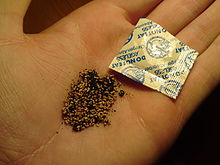- Oxygen absorber
-
The contents of an oxygen absorber from a packet of beef jerky.

An oxygen absorber is a small packet of material used to prolong the shelf life of food. They are used in food packaging to prevent food colour change, to stop oils in foods from becoming rancid, and also retard the growth of oxygen-using aerobic microorganisms such as fungi.
Oxygen supports the growth of microorganisms and causes changes in color and rancid odors in packaged foods. Plastic packaging is less able to exclude oxygen from packaged foods than are the older glass and metal containers. Oxygen absorbers absorb oxygen and effectively reduce the aerobic environment to 0% oxygen. Therefore aerobic bacteria and fungi are unable to grow in this environment. This will extend the shelf life of a food product from 1 week to several months. The advantages of oxygen satchels versus vacuum packaging are that the food products are not crushed or squeezed, as some products are of high value and are fragile, and its simplicity of use.
The packaging itself and the food bag /container seal are crucial for the effectiveness of the oxygen absorber. A minor packaging fault or leak can render the oxygen absorber useless and the contents inside the package will perish. Thus, high barrier packaging (with a low oxygen transmission rate) and efficient seal techniques need to be employed.[1]
Oxygen absorbers are made in different formulations to match the water activity of the foods they are protecting. Some are designed to be used in dry foods such as nuts and dried grains, others with moister foods such as bread and processed meats. In most formulations the active ingredient is iron powder and a little bit of water; other ingredients may be added to make the oxygen absorbers work more efficiently.
See also
- Active packaging
- Scavenger (chemistry)
References
- ^ Cichello, Dr. Simon. "A Guide to Oxygen Absorbers". Wholesale Group International Pty Ltd. http://www.oxygenabsorber.net/Oxygen%20Absorbers%20Introduction.pdf. Retrieved March 2010.
- Yam, K. L., "Encyclopedia of Packaging Technology", John Wiley & Sons, 2009, ISBN 978-0-470-08704-6
Categories:- Packaging
- Food additives
- Food stubs
Wikimedia Foundation. 2010.


